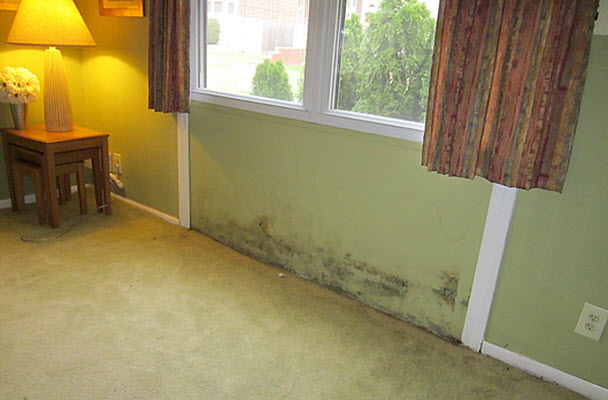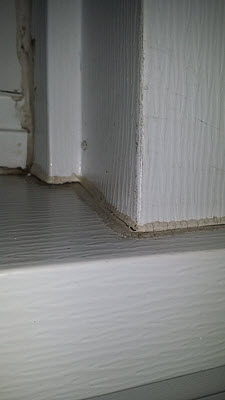[vc_row][vc_column width=”1/2″][vc_column_text]


[/vc_column_text][/vc_column][vc_column width=”1/2″][vc_column_text]You probably already know that old, poorly sealed windows cost you money in increased heating and cooling bills. Lots of blogs advise caulking around your windows on the interior of your home to prevent drafts and heat loss.
But there’s a better reason to caulk around the exterior of the windows in your home: Caulking can prevent mold damage.
You see, mold can’t grow without water.
Old, cracked acrylic caulk around windows and doors allows the elements to leak into your home.
Leaks are never a good thing, but they’re even more dangerous when you assume they don’t exist.
For example, if you’ve had new windows installed, you may not know there is an intentional ¼” or larger gap between the siding and the window frame to allow for expansion.
Unless these gaps have been sealed with flexible silicone caulk, water will seep in between between the sheathing and interior wall and get trapped in your insulation.
Once it’s there, the moisture will start to rot the wood around the windows and activate any latent mold spores to feed off the gypsum drywall. And professional mold remediation could cost you thousands to repair the damage.
So now’s the time to inspect your property and caulk around windows and doors to prevent drafts, save energy, keep moisture from rotting the wooden window parts and prevent mold damage in the casings.[/vc_column_text][/vc_column][/vc_row][vc_row][vc_column][vc_column_text]
Here’s how to prevent mold damage to your home or business with silicone caulk:
Make sure you pick a day that’s dry. Silicone is permanently waterproof, flexible, shrink and crack-proof once it’s dry, so it provides sustained benefits. But it’s best to install it during dry weather to get the best seal.
Things you’ll need:
- Putty knife or scraper
- Utility knife
- Household cleaner or rubbing alcohol
- Long nail or wire hanger to pierce the tube of caulk
- Popsicle stick or plastic spoon
- Caulk gun and silicone caulk – It’s hard to say how much caulk you’ll need for all the windows and doors of your home, but the Department of Energy suggests that one tube of caulk should be enough for two average-sized windows.
- And always have a damp -not wet -rag nearby
Now let’s get started:
- First, use the putty knife to scrape off any old caulk.
Then, clean the surface with a household cleaner or rubbing alcohol and wipe with a clean cloth. Make sure the surface is clean, dry, and free of soap, grease, dirt, and dust before caulking so you can get the best seal. - Next, cut a very small piece off the end of the caulk tube at a 35-45 degree angle, just large enough to create a bead to fill the cracks. A ¼ inch bead is usually big enough to fill most cracks. If you need a larger bead simply cut a bit more off the tip of the caulk tube.
A word of caution here:
If the space you are sealing is too big (exceeds 1/2″ x 1/2″), it’s not a matter of adding more caulk. First you’ll need a backer rod, which is an extruded foam rod that is typically placed in deep joints to fill in some of the space before the caulk is applied.[/vc_column_text][/vc_column][/vc_row][vc_row][vc_column width=”1/2″][vc_column_text]

[/vc_column_text][/vc_column][vc_column width=”1/2″][vc_column_text]3. Next, puncture the tube with the wire hanger or long nail to make the caulk flow.
4. To apply the caulk, move the caulk gun at a measured pace along the crack using continuous light pressure on the gun trigger. Caulk on all 4 sides of the window to seal the cracks.
A word of caution here:
Avoid getting caulk on window panes. It won’t hurt the glass, but it’s a pain to remove.
5. The last step is to smooth the caulk with the plastic spoon or popsicle stick. Wipe any excess caulk on the damp rag nearby.
When you’re finished you’ll have an almost invisible flexible seal that will prevent moisture from entering your home and prevent mold damage too.[/vc_column_text][/vc_column][/vc_row][vc_row][vc_column][vc_column_text]
If the job looks too big for you to handle and you need help call
Ray Weise at Mr. Handyman 856-481-0910
If it’s too late for prevention, and you already suspect that rainwater damage has caused mold damage give us a call at 877-750-7876
[/vc_column_text][/vc_column][/vc_row]
